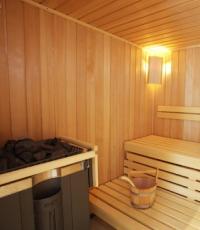Do-it-yourself rocket stove made of long-burning bricks. Brick rocket stoves Video: a variant of the simplest rocket stove from an old cylinder
The oven is simple and does not require any super abilities and knowledge of the oven business) Simple and for the people! The main charm of the stove is, of course, its budget, because every owner of a private house or cottage has a couple of dozen used bricks, red ceramic. The second indisputable plus of the stove is its economy, due to the afterburning of flue gases, which actually increases its efficiency.
First, the base is laid out on a pre-leveled area, namely 1 half and 4 whole bricks, in the second row we form a firebox and lay a half of a brick in the left corner, then we shift this corner with a brick, and in the front part we get a hole for laying firewood and air access to the combustion center . The third and subsequent rows are completely identical to each other, we raise the pipe and report the remaining brick.
You can use the stove for boiling water, cooking, by the way, it’s great to cook jam on it) also, who is engaged in subsidiary farming, then you can cook porridge or some kind of brew for animals)
Material
Instruments
1. crazy hands))
Laying instructions rocket oven from bricks with their own hands.
And so, first of all, the site is leveled, we remove all unnecessary and unnecessary from the construction site. Here the author previously made a base from used bricks and it turns out that the masonry has already begun from the second row. The first row is the base.
2nd row, a half of a brick is taken and 3 more whole ones are laid as shown in the photo below.

3 row is formed firebox.


4 and subsequent rows are placed to raise the pipe.







You can also watch the video filmed by the author on laying the rocket furnace, which shows the whole process in more detail from start to finish. The work of the furnace, live fire, enjoy watching)
A simple brick rocket oven: drawings, masonry scheme, step by step photos. How to make a simple 20 brick rocket oven in 5 minutes DIY detailed description with video.
If you need to quickly build a simple outdoor stove, you can use a rocket-type stove. The peculiarity of this stove is that it consumes very little fuel, can work on wood chips, and heats very well, on the stove you can not only boil water, but also cook food.
To build a stove, you will need two dozen bricks, any brick is suitable, silicate, red, and of course refractory. So nothing more is needed, even masonry mortar is not necessary to use.

As you can see in the diagram, the furnace consists of 21 bricks, the base of the furnace is laid out first.

The second row is laid out of 3 whole bricks and 1 half, this is the lower part of the firebox.



That's all, our rocket oven is ready to use, it will take less than 5 minutes to build it. Now I will tell you the principle of operation of this furnace.

We put fuel in the stove (you can use any wood, chips, branches, pine needles and cones) and set it on fire. Then you need to give a little time for the walls of the furnace to warm up, after which the flame begins to burn well and practically does not smoke.
This unusual view heating systems not familiar to ordinary builders. Many professional stove-makers have also never encountered such designs. This is not surprising, since the idea of a rocket stove came to us from America relatively recently, and today enthusiasts are trying to bring it to the mass consciousness of citizens.
Due to the simplicity and low cost of construction, thermal comfort and high efficiency, rocket furnaces deserve a separate article, which we decided to devote to them.
How does a rocket oven work?
Despite the loud space name, this heating structure has nothing to do with missile systems. The only external effect that gives some resemblance is a jet of flame that breaks out of a vertical pipe near the camp version of the rocket stove.
The work of this hearth is based on two basic principles:
- Direct combustion - the free flow of fuel gases through the furnace channels without being stimulated by the draft created by the chimney.
- Post-combustion of flue gases released during the combustion of wood (pyrolysis).
The simplest jet furnace works on the principle of direct combustion. To achieve thermal decomposition of wood (pyrolysis), its design does not allow. To do this, it is necessary to perform a powerful heat-accumulating coating of the outer casing and high-quality thermal insulation of the inner pipe.

Despite this, portable rocket stoves perform their functions well. They don't require a lot of power. The generated heat is enough for cooking and heating in the tent.
Rocket furnace designs
To begin acquaintance with any design should be with its simplest options. Therefore, we present a diagram of the operation of a mobile rocket stove (Fig. 1). It clearly shows that the firebox and the combustion chamber are combined in one piece of steel pipe, bent up.
For laying firewood, a plate is welded in the lower part of the pipe, under which there is an air hole. Ash, which plays the role of a heat insulator, helps to enhance heat transfer in the cooking zone. It is poured into the lower part of the outer casing.

The secondary chamber (casing) can be made of metal barrel, bucket or old gas cylinder.
In addition to metal, the simplest rocket furnace can be built from several dozen bricks even without the use of mortar. A firebox and a vertical chamber are laid out of them. Dishes are placed on its walls so that there is a gap under the bottom for the exit of flue gases (Fig. 2).

A prerequisite for the good work of such a design is “ warm pipe", as the stove-makers say. In practice, this means that before laying firewood, the rocket stove must be warmed up for several minutes, burning wood chips and paper in it. After the pipe is warmed up, the firewood is stacked in the firebox and set on fire, a powerful upward flow of hot gases appears in the furnace channel.
Bookmark fuel in simple designs rocket furnaces horizontal. This is not very convenient, because it forces you to periodically push the firewood into the firebox as it burns out. Therefore, in stationary systems, a vertical bookmark is used, and air is supplied from below through a special blower (Fig. 3).

Burning out, the firewood itself falls into the oven, saving the owner from manual feeding.
Main dimensions
A visual representation of the configuration of a stationary rocket furnace long burning gives drawing #1.

Anyone who wants to build a stationary rocket furnace, without being distracted by simplified modifications, must know its basic dimensions. All dimensions of this design are tied to the diameter (D) of the cap (drum) covering the vertical part of the flame tube (riser). The second dimension required for calculations is the cross-sectional area (S) of the cap.
Based on the two indicated values, the remaining dimensions of the furnace structure are calculated:
- The cap height H is between 1.5 and 2D.
- The height of its clay coating is 2/3H.
- Coating thickness - 1/3D.
- The cross-sectional area of the flame tube is 5-6% of the cap area (S).
- The size of the gap between the cap cover and the upper edge of the flame tube should not be less than 7 cm.
- The length of the horizontal section of the flame tube must be equal to the height of the vertical one. Their cross-sectional areas are the same.
- The blower area should be 50% of the cross-sectional area of the flame tube. To ensure a stable operation of the furnace, experts recommend making a flame channel from a rectangular metal pipe with an aspect ratio of 1:2. She is laid flat.
- The volume of the ash pan at the exit from the furnace to the external horizontal smoke channel must be at least 5% of the volume of the cap (drum).
- The external chimney must have a cross-sectional area between 1.5 and 2S.
- The thickness of the adobe insulation pad, which is made under the external chimney, is chosen in the range from 50 to 70 mm.
- The thickness of the adobe coating of the bench is chosen equal to 0.25D (for a drum with a diameter of 600 mm) and 0.5D for a cap with a diameter of 300 mm.
- The external chimney must be at least 4 meters high.
- The length of the flue in the bed depends on the diameter of the cap. If it is made from a 200-liter barrel (diameter 60 cm), then you can make a bed up to 6 meters long. If the cap is made of a gas cylinder (diameter 30 cm), then the bench should not be longer than 4 meters.
When building a stationary rocket furnace, you need to pay Special attention the quality of the lining of the vertical section of the flame tube (riser). For this you can use refractory brick brand ShL (light fireclay) or washed river sand. To protect the lining from flue gases, it is made in a metal shell, using old buckets or a galvanized sheet for this.




Sand filling is done in layers. Each layer is compacted and lightly sprayed with water. After making 5-6 layers, they are given a week to dry. Thermal protection from fireclay is easier to make, but the space between the outer shell and the brick will also have to be covered with sand so that there are no empty cavities (Fig. 4).

Figure No. 4 scheme of the lining of the flame channels of rocket furnaces
After the backfill has dried, the upper edge of the lining is coated with clay, and only after that the installation of the jet rocket furnace is continued.
Advantages and disadvantages of rocket stoves
An important advantage of a properly constructed structure is omnivorousness. Such an oven can be heated by any type solid fuel and wood waste. Moreover, the moisture content of wood does not play a special role here. If someone claims that such a stove can only work on well-dried wood, then this means that gross mistakes were made during its construction.

The heat output of the rocket furnace, which is based on a barrel drum, is very impressive and reaches 18 kW. A gas cylinder stove is capable of developing a thermal power of up to 10 kW. This is quite enough for heating a room with an area of 16-20 m2. We also note that the adjustment of the power of rocket furnaces is carried out only by changing the volume of loaded fuel. It is impossible to change the heat transfer by supplying air. The blower adjustment is used only to enter the furnace into operating mode.

Since the amount of heat generated by the rocket oven is very large, it is not a sin to use it for household needs such as heating food (on the drum cover). But it is impossible to use such a hearth to heat water used in a radiator heating system. Any introduction of coils and registers into the furnace design adversely affects its operation, worsening or stopping the pyrolysis process.
Useful advice: before you start building a stationary jet furnace, make a simplified camp structure from metal or clay. So you will work out the basic assembly techniques and get useful experience.
The disadvantages of rocket stoves include the impossibility of their use in baths and garages. Their design is designed for energy storage and long-term heating. Therefore, it cannot give a lot of heat in a short period of time, as is necessary in the steam room. For garages that store fuels and lubricants, an open flame oven is also not the best option.
We assemble a rocket stove with our own hands
The easiest way is to assemble a camping-garden version of a jet stove. To do this, you do not have to purchase masonry materials and prepare adobe for coating.
A few metal buckets, a stainless steel pipe for the flame channel and small gravel for backfilling - that's all you need in order to make a do-it-yourself rocket furnace.

First step- cutting holes in the lower bucket with scissors for metal to pass the flame tube. It must be done at such a height that there is room under the pipe for crushed stone backfill.
Second step- installation in the lower bucket of a flame tube, consisting of two elbows: a short boot and a long one for the outlet of gases.
Third step- cutting a hole in the bottom of the upper bucket, which is put on the lower one. The head of the frying pipe is inserted into it so that its cut is 3-4 cm above the bottom.
Fourth- backfilling with small gravel in the lower bucket at half its height. It is needed for heat accumulation and thermal insulation of the flame channel.
Last step- production of a stand for dishes. It can be welded from round reinforcement with a diameter of 8-10 mm.
A more complex, but at the same time durable, powerful and aesthetic version of the rocket stove requires the use of a gas cylinder and a thick rectangular steel pipe.

The assembly scheme does not change. The exhaust gas here is organized on the side, and not at the top. For cooking, the upper part with a valve is cut off from the cylinder and a flat round plate 4-5 mm thick is welded in its place.
The rocket furnace has never visited space and, of course, is not used to heat space objects. Its name comes from its external resemblance to an inverted rocket, and besides, some of its models hum strongly during kindling. In construction, this is the most a budget option furnace design, requiring a minimum amount of materials. A hearth of this type is being built and used in 2 versions: outdoor for cooking, heating water, heating in field conditions and stationary for space heating
What is this article about
Outdoor rocket stove
The stove for the street can be factory-made or built independently from bricks.
Factory modification is sold under the name "Robinson. Furnaces are metal, but according to the principle of construction and combustion, they are no different from home-made ones.

Technically, they are an L-shaped device. The firewood receiver is diagonal or vertical, but the fuel is ignited through the vertical part of the structure. The factory version also has a small blower that controls the access of air needed for traction.

From bricks, a jet stove for the street can be folded in just 10 minutes. It does not require a solution, it consists of 5 rows, 4 bricks in each. Since the container is heated by an open flame, it does not require much fuel, but at the same time it is able to boil a fairly large amount of water in a short time.
The only thing is that it is necessary to put a grate for the container on it, if the saucepan or barrel blocks the completely vertical exit, there will be no good draft in the oven.
Regarding fuel, the stove works on wood, cones, chips, leaves, and so on, that is, it is a hearth that is not picky about kindling.
Indoor Rocket Oven
Improved street model. It can be built from brick, stone, clay, but most often, it is the brick version that is used.

TO the advantages of such a rocket stove relate:
- Relatively easy installation.
- Significant efficiency. It can heat up to 60 square meters, depending on the design.
- The possibility of arranging a stove bench, a stove for cooking, a fork in the floor to heat the surface.
- Not picky about fuel even with a low calorific value.
- Almost complete combustion of soot.
- The possibility of masking the furnace with a heat-intensive lining (most often adobe plaster is used).
- The operating mode is about 6 hours with one bookmark of fuel.
To the disadvantages:
- The need for constant supervision of the furnace.
- High temperatures of the metal cap, which can cause burns. In this zone, the temperature can reach 900-1200 degrees.
A rocket furnace of this type works on the principle of direct combustion and afterburning of pyrolysis, that is, wood gases, which enhances its heat transfer.

The principle of operation is this:
- Kindling firewood in the firebox.
- From their combustion, a natural flow of hot gases arises.
- In the lower part of the horizontally located channel there is a secondary hole for supplying oxygen, due to which pyrolysis and its afterburning are formed.
- Hot gases rush into the raiser and cap.
- Thanks to the cap, the pressure is discharged, and a new portion of hot gases enters there again, displacing the old ones.
- Gases pass between the pipe and the hood, heating this space, and then exit into the chimney.
When burning, the stove should make sounds similar to a slight rustle. If it hums, it means that too much air is getting into the firebox.
Design features
The rocket furnace has its own construction features:
- The height of the cap can be from 1.5 to 2 parts of its diameter.
- The coating of the cap occurs no more than 2/3 of the part, and its thickness is usually 1/3 of the diameter.
- The cross-sectional area of the riser (chimney) is approximately 5% of the area of the cap, and at the same time, at least 7 cm of clearance remains between it and the upper part of the drum for free circulation of gases.
- A horizontally running pipe is equal in diameter and height to a vertical one. The outer pipe is 1.5–2 parts in cross section from the drum area, its length reaches at least 4 meters.
- If a bench is used in the structure, the length of its flue is also tied to the diameter of the drum to ensure high-quality heating of the pipes. So for a barrel with a diameter of 60 cm, the flue can be made, for example, 6 meters in length.
- The blower is performed on 50% of the total area of the flame tube.
Modifications
A rocket stove may have a hob, a water heating tank, a water heat exchange circuit and a bench.
With sunbed
This is the most common modification.
In such a jet stove, the bed can be made of stone, brick, clay, under which hot air circulates through an elongated horizontal chimney and exits. end up vertical chimney. Such a stove with a stove bench or bench keeps heat up to half a day. The body of the oven is most often equipped with a hob for heating water and cooking.
For cleaning soot, a special cleaning door is provided, which is located between the gas outlet from the furnace body and the channel chimney system.
FROM ondolyu (warm floor)
This heating system comes from Korea and is the ancestor of the "warm floor". Unlike the previous version, the gas flue labyrinth is arranged under the floor of the houses, ensuring its heating.
As a coil, special metal pipes, insulated with non-combustible materials or brick channels.
Hot air still circulates through the channels, warming the floor surface.

With water heat exchanger or water heating tank
Such a furnace has a huge number of variable design schemes. Since the danger from such a furnace due to boiling water is even higher, when arranging it, it is imperative to check the scheme used and take it only from authoritative sources and with expert advice.
With the right arrangement, the rocket stove will successfully be able to fully heat the room and long years serve their masters.





